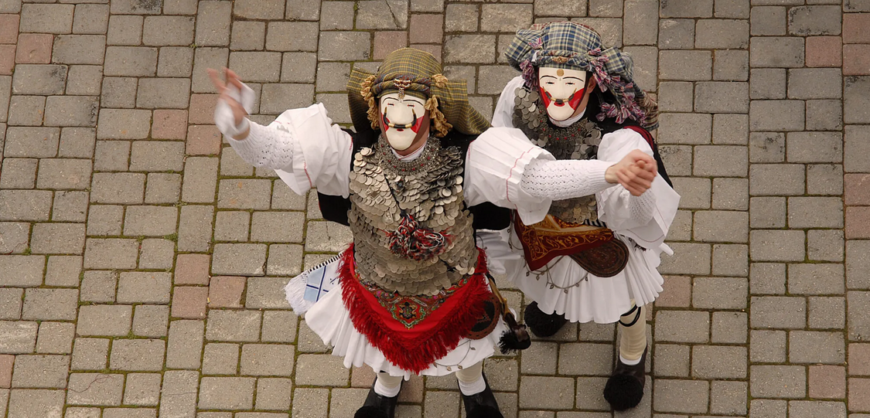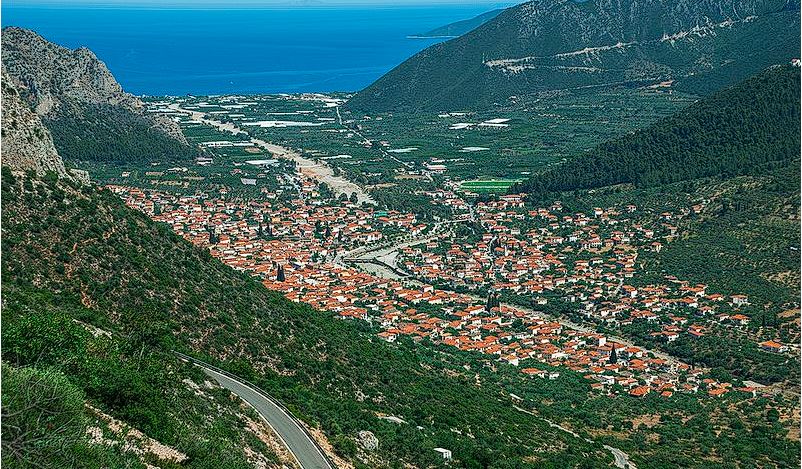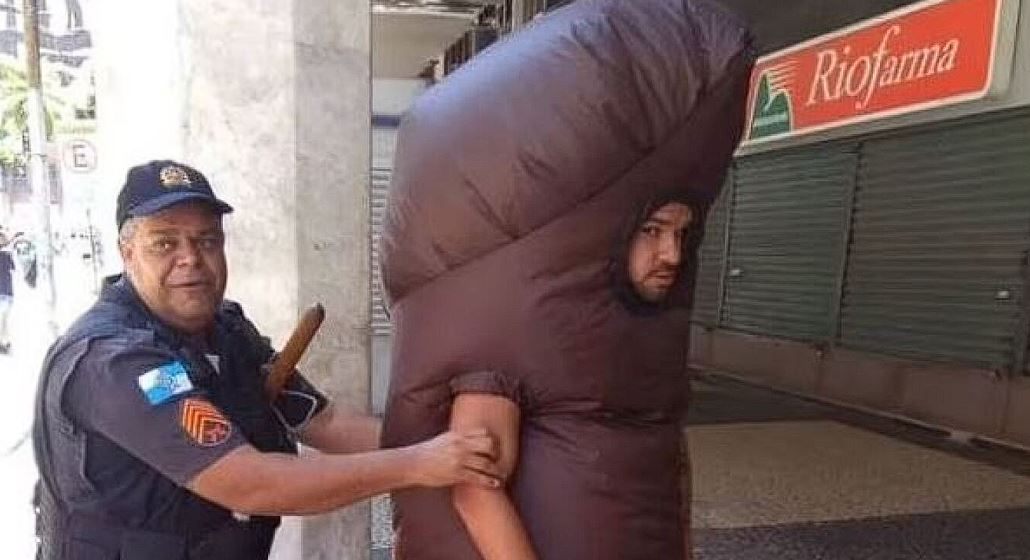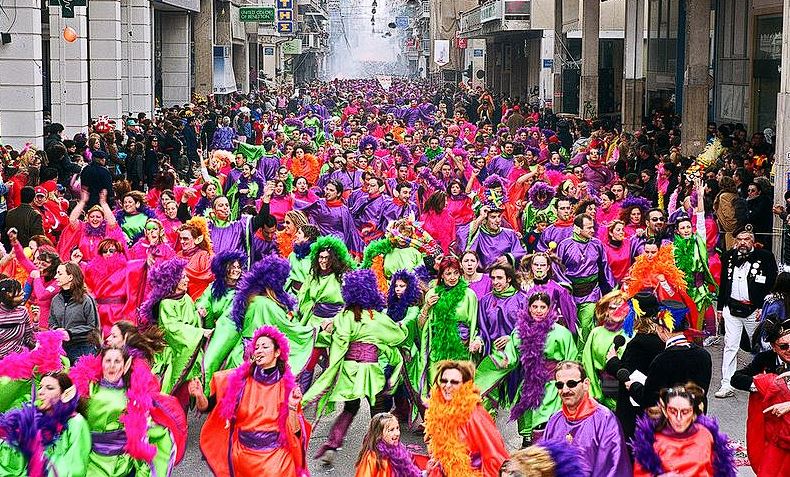Carnival customs are rooted in villages and cities across the country, filling the streets and squares with colors and music. Where to (first) go to truly experience the Greek carnival traditions?
The three weeks before Clean Monday are traditionally weeks of abstinence from meat, hence the name “Apokries” (Carnival in Greek). This is precisely what the Latin word carnival means (from the words Carne, meaning meat, and Vale, meaning farewell). Apokries is a tradition rooted in antiquity and carries mystagogy, which, in some parts of Greece, still holds strong.
Disguises, generally, are ancient customs with a propitiatory character, aiming to ensure the health, fertility, and fruitfulness of the land, similar to the ancient Dionysian celebrations. Thrace is the birthplace of all these pagan customs, as Dionysus was born here. This is supported by Mrs. Penelope Kambaki-Vougioukli, professor of linguistics and dean of the School of Classical and Humanities Studies at Democritus University. Wine, ecstasy in dance, and an amorous mood prevail during Apokries, with the outspokenness and sarcasm prevailing in many songs being a verbal representation of sex.
The names of the disguises differ from place to place: bell-wearers, camels, masked men, and carnival-goers, deriving from the Italian words maschera and carnevale.
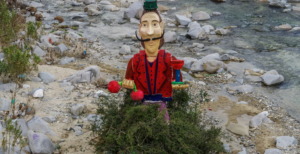
The Crazy Carnival of Xanthi
Carnival in Xanthi means “burning of the effigy.” On the last Sunday of Carnival, at the bridge of the Kosynthos River, locals and visitors watch as a human effigy placed on a pile of branches is set on fire, aiming to ward off evil – in this case, the removal of fleas during summer. The custom originated from the Greek refugees of Samakov in Eastern Thrace and is revived every year. Xanthi’s carnival is the institution with the longest history in the city, since 1966, and the second-longest in all of Greece, after Patras. Visitors from Bulgaria, Turkey, and Romania come every year to witness the carnival up close, participating in the parade.
Didymoteicho’s Carnival
Here, the custom of the Bey dominates, containing Dionysian elements and having a satirical character. Everyone dresses in improvised old clothes. After the end of the “Bey’s tour,” there is a reenactment of local activities, such as plowing and harvesting by farmers, followed by a donkey race and Grec-Roman wrestling. The event concludes with a wine celebration and traditional dishes at local taverns with traditional instruments of the region. Folklorist Paschalis Kontos characterizes the custom of the Bey as conspiratorial, denying its idolatry: “The custom clearly seems to have been contrived for some serious reason of national expediency. This view is also supported by the functionality of the custom. The grandeur in this case lies in its conspiratorial perfection. Those who participated in the contrivance of the custom were well aware of our Mythology, the customs of the conqueror, and were aware of the tragic circumstances for the terrible plight of Hellenism”.
Δείτε αυτή τη δημοσίευση στο Instagram.
Kastoria with the “Boubounes” and the “Haskari”
On the last Sunday of Carnival, fires are lit in the squares of Kastoria and in the villages, and there is chaos with feasting and revelry all around. The biggest “Boubounes” are at Doltso Square, the Apozari neighborhood, Omonia Square, and the area around the Old Hospital. Folk bands play local traditional tunes, and dancing follows until the “Boubouna” goes out, taking with it the evil spirits, according to the custom. In several households, the custom of “Haskari” is still observed.
After dinner, everyone is entertained by the efforts of the family and friends to crack a boiled egg wide open with their mouths. This egg is offered to them with the help of a wooden stick and a thread, a custom related to the fasting period: with an egg, they “close” their mouths to fast, and with an egg, they “open” them again on the night of the Resurrection when fasting is over.


Kozani in Flames
A lively custom prevails there, relying on the spontaneous participation of the residents, reviving a tradition: food, wine, dance, song, and banter prevail, creating an authentic Carnival atmosphere. The “Fanoi” are lit, large fires that accompany the singing of the locals in the Kozani dialect, one in each neighborhood throughout the Carnival period. On the last Sunday, the fires are lit simultaneously everywhere, and the city is filled with ecstasy.

The “Babogeros” of Serres
On Cheese Sunday and Clean Monday, in the village of Flambouro in Serres, the custom of the “Babogeros” is revived, originating from ancient times. The carnival participants, called “Babogeros,” wear black or brown skins from lambs and goats that they have processed themselves. They belt around their waist bells of different sizes and reverently place on their heads a two-meter-long, black pointed hat, called “babousarka,” adorned with dozens of colorful ribbons, beads, and scarves. Only their eyes can be seen. Early in the morning, the “Babogeros,” after receiving their mother’s blessing, head to the church to receive the grace of Saint Anna and then visit every house in the village with the aim of dispelling evil and bringing good luck, prosperity, and health. The custom of the “Babogeros” concludes on Clean Monday with a big feast held in the village square in a solemn manner, a delight for the visitor’s eyes.
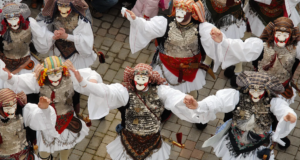
The Carnival in Naousa, Imathia
The “Boules” is a dance event with quite strict rules derived from ancient ritualistic practices with the traditional instrument of zournades and drums, strictly involving only men. In the past, young boys also participated. The custom begins early in the morning on the eve of Cheese Sunday, where the dressing begins, which is elaborate and luxurious with silverware and expensive fabrics sewn one by one onto a specially designed vest. The last addition to complete the Boules costume is the characteristic, quite elaborate headgear. Also, unique is the traditional mask called “Prosopos” or “Prosopida,” perhaps the most important accessory of the attire.
Δείτε αυτή τη δημοσίευση στο Instagram.
The Carnival Fires in Ioannina
“Tzamalas” are the large carnival fires that are lit every year in different neighborhoods of the city of Ioannina on the last Sunday before the beginning of Lent. Around them, there is a celebration every year with lots of dancing and wine that lasts until dawn, with the custom considered a springtime purification to usher in the new season, meaning the one that will come after winter. The cultural associations of each neighborhood, in collaboration with the municipality, take care of the wood, sand, and wine, of course. The flames rise towards the sky and illuminate the whole neighborhood. In the past, there was a competition between neighborhoods for the biggest “Tzamala.” Undoubtedly, a spectacular sight.
Δείτε αυτή τη δημοσίευση στο Instagram.
The Bell-Bearers of Soho
One of the oldest customs that has been transferred and celebrated unchanged to this day during Carnival in Soho, Thessaloniki, is the “Bell-Bearers.” According to the custom, carnival revelers in goat-shaped costumes dance joyfully in the streets and squares. According to tradition, the elders forgive the sins of the younger ones, and this is the famous custom of repentance, where the younger ones kiss the elders’ hands, offering them an orange. Alongside the festivities, a traditional wedding takes place, reenacting a parody of a wedding ceremony on Carnival Sunday.
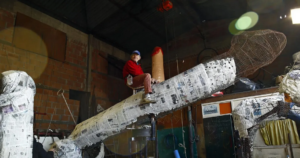
Bourani in Tyrnavos
In Tyrnavos, the city of tsipouro, Carnival is called “Bourani” and stands out for its Dionysian atmosphere, the playful teasing, and the enormous phalluses, either on carnival floats or as bottles for wine and tsipouro. “Bourani” is also the name of a soup made from wild greens, such as wild chicory, which is prepared on Clean Monday in a large cauldron, shared with the guests, and of course, accompanied by tsipouro, ouzo, and wine. The origin of this custom dates back deep into antiquity. “Bourani” honors the phallus as a symbol and source of renewal and fertility, things so crucial in a region connected with agriculture and animal husbandry. It is certain that Tyrnavos deserves to be your destination for Carnival.
Island Carnival in the Aegean
In Serifos and Amorgos, the tradition of the “Captain” comes alive in the morning of Tyro’s Sunday: local young men, dressed in trousers with a belt around the waist, with scarves and traditional vests decorated crosswise with colorful ribbons, dance and are accompanied by musicians singing serenades and the famous “Apokrianos”: “Carnival has passed, and the Tyrians too…”. In Skopelos, on the last Sunday of Carnival, men dressed in their most makeshift clothes hold in their hands a small boat made of reeds and wood, the famous “Trata”. They roam around the entire town dancing and singing indecent and mocking Carnival songs and occasionally throw their nets, catching passersby. The group following the “Trata” is in a similar mood, dancing and singing, masked at will. This impressive custom in motion represents the corsairs who roamed the islands stealing and terrorizing the locals.
Ionian Sea
A traditional town crier goes around the island of Zakynthos, announcing, as it was done in the past, the carnival program. Throughout the Carnival period, there are dances, parades, and other events. On the Sundays of Carnival and Tyro’s Sunday, the Carnival procession takes place, accompanied by floats from all areas of the island, while the events conclude with the very entertaining “Funeral of the Mask”. The place of the deceased (!) is taken by the Carnival, followed by the mournful relatives with incredible performances and shows during the duration. An experience that if you haven’t lived, it’s definitely worth daring, and even actively participating.
Δείτε αυτή τη δημοσίευση στο Instagram.

